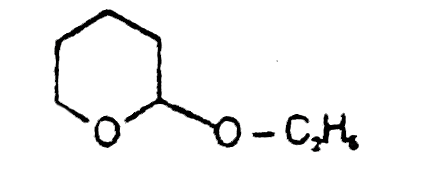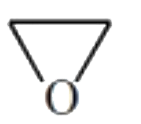Reaction of propanal with HCN followed by acid hydrolysis of the reaction product with produce
propanoic acid
1-butylamine
α-hydroxybutanoic acid
all of the above
The correct Answer is:C
To solve the question regarding the reaction of propanal with HCN followed by acid hydrolysis, we can break down the process into clear steps:
1. Identify the Reactants:
- The reactant is propanal (CH3CH2CHO), which is an aldehyde.
- The other reactant is hydrogen cyanide (HCN).
2. Nucleophilic Addition Reaction:
- In the presence of HCN, the cyanide ion (CN⁻) acts as a nucleophile and attacks the carbonyl carbon of propanal.
- The reaction can be represented as:
CH3CH2CHO+HCN→CH3CH2C(OH)(CN)H
- This results in the formation of a cyanohydrin, specifically 2-cyanopropanol.
3. Acid Hydrolysis:
- The next step involves the hydrolysis of the cyanohydrin in an acidic medium (H⁺ and H₂O).
- The hydrolysis of the cyanohydrin leads to the formation of a carboxylic acid and the release of ammonia:
CH3CH2C(OH)(CN)H+H2OH+−−→CH3CH2C(OH)(COOH)H
- This results in the formation of 2-hydroxybutanoic acid.
4. Naming the Product:
- The product formed is 2-hydroxybutanoic acid, which can also be referred to as alpha-hydroxybutanoic acid because the hydroxyl group (-OH) is located at the second carbon (alpha position) of the butanoic acid chain.
Final Product:
The final product of the reaction of propanal with HCN followed by acid hydrolysis is alpha-hydroxybutanoic acid.
- The reactant is propanal (CH3CH2CHO), which is an aldehyde.
- The other reactant is hydrogen cyanide (HCN).
- In the presence of HCN, the cyanide ion (CN⁻) acts as a nucleophile and attacks the carbonyl carbon of propanal.
- The reaction can be represented as:
CH3CH2CHO+HCN→CH3CH2C(OH)(CN)H
- This results in the formation of a cyanohydrin, specifically 2-cyanopropanol.
- The next step involves the hydrolysis of the cyanohydrin in an acidic medium (H⁺ and H₂O).
- The hydrolysis of the cyanohydrin leads to the formation of a carboxylic acid and the release of ammonia:
CH3CH2C(OH)(CN)H+H2OH+−−→CH3CH2C(OH)(COOH)H
- This results in the formation of 2-hydroxybutanoic acid.
- The product formed is 2-hydroxybutanoic acid, which can also be referred to as alpha-hydroxybutanoic acid because the hydroxyl group (-OH) is located at the second carbon (alpha position) of the butanoic acid chain.
The final product of the reaction of propanal with HCN followed by acid hydrolysis is alpha-hydroxybutanoic acid.
Similar Questions
Knowledge Check
Cumene on reaction with oxygen followed by hydrolysis gives
ACH3OH and C6H5COCH3BC6H5OHand(CH3)2OCC6H5OCH3 and CH3OHDC6H5OH and CH3COCH3Which of the following reactions produce the same product?
A B
B C
C D
D
Which of the following reactions produce the same product?
A B
B C
C D
D
The reaction of RCN with R'MgX, followed by hydrolysis gives
View SolutionThe reaction of benzaldehyde with HCN followed by hydrolysis gives ………………
View SolutionThe product of acid hydrolysis of

is
View SolutionThe reaction of CH3Mgl with acetone and hydrolysis of the resulting product gives :
View SolutionReaction of propanone with methylmagnesium bromide followed by hydrolysis gives :-
View Solution

 The reaction of Oxirane with RMgX followed by hydrolysis will lead to product ?
The reaction of Oxirane with RMgX followed by hydrolysis will lead to product ?